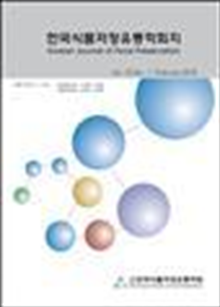간행물
한국식품저장유통학회지 (Korean J. Food Preserv.) KCI 등재 SCOPUS 한국식품저장유통학회지 The Journal of Korean Society of Food Preservation

- 발행기관 한국식품저장유통학회
- 자료유형 학술지
- 간기 연7회
- ISSN 1738-7248 (Print)2287-7428 (Online)
- 수록기간 1994 ~ 2018
- 주제분류 농수해양 > 식품과학 농수해양 분류의 다른 간행물
- 십진분류KDC 521DDC 630
권호리스트/논문검색
제19권 제2호 (2012년 4월) 22건
21.
2012.04
서비스 종료(열람 제한)
Two hundred and twenty three yeast strains were randomly isolated from Korean traditional nuruk. Among them, six urease producing yeast strains (designated JJA, JJB, JJ22, SHA, SHC and SH10) were selected on the Christensen urea agar plates. They showed the same pattern in the PCR-RFLP analysis of the ITS I-5.8S-ITS II region digested with HaeIII and HinF1 restriction endonucleases. Its DNA sequences showed 100% (strains SHA, SHC and SH10) and 99.8% (strains JJA, JJB and JJ22) identity with those of Issatchenkia orientalis type strain ATCC 24210. Phylogenetic analysis resulted in that all the strains were closely related to I. orientalis. Two representative strains, JJ22 and SH10, showing the highest urease activities were selected for further characterization. Their morphological, physiological and biochemical characteristics were also the same as I. orientalis. Therefore, both the two strains were identified as I. orientalis. They could grow at a wide range of temperature between 20-40℃ as well as pH between 2.0 and 10.0. However, a higher level urease activity were obtained at acidic pH than that at alkalic pH. The maximal level of urease activity was obtained at 30℃ (strain SH10) or 35℃ (strain JJ22) and in a liquid medium adjusted to the initial pH 5.0.
22.
2012.04
서비스 종료(열람 제한)
The in vivo single-dose acute toxicity of Lactobacillus plantarum AF1, a lactic acid bacterium isolated from kimchi, in ICR male and female mice was investigated. The test article was intraperitoneally or orally administered once to both sexes of mice. The motalites, clinical findings, autopsy findings, and body weight changes were monitored daily for 14 days. In the oral acute toxicity test, the male and female mice were gavaged with four doses (5.0, 2.5, 1.25 and 0.625 g/kg) of Lb. plantarum AF1. The oral LD50 of the Lb. plantarum AF1 was considered higher than 5.0 g/kg. In the intraperitoneal acute toxicity test, mice were injected intraperitoneally with dosages of 0.7, 0.9, 1.1, 1.3, 1.5, 1.7, 1.9, 2.1, 2.3 and 2.5 g/kg. The intraperitoneal 50% lethal dose (LD50) of the Lb. plantarum AF1 was >2.5 g/kg in the male and female mice. No significant changes in the general conditions, body weights, clinical signs, and gross lesions were observed in both sexes of mice to which Lb. plantarum AF1 was administered intraperitoneally or orally. The results suggest that the no-adverse-effect level of Lb. plantarum AF1 is estimated to be more than 5.0 g/kg in the oral route and 2.5 g/kg in the intraperitoneal route.
1
2

